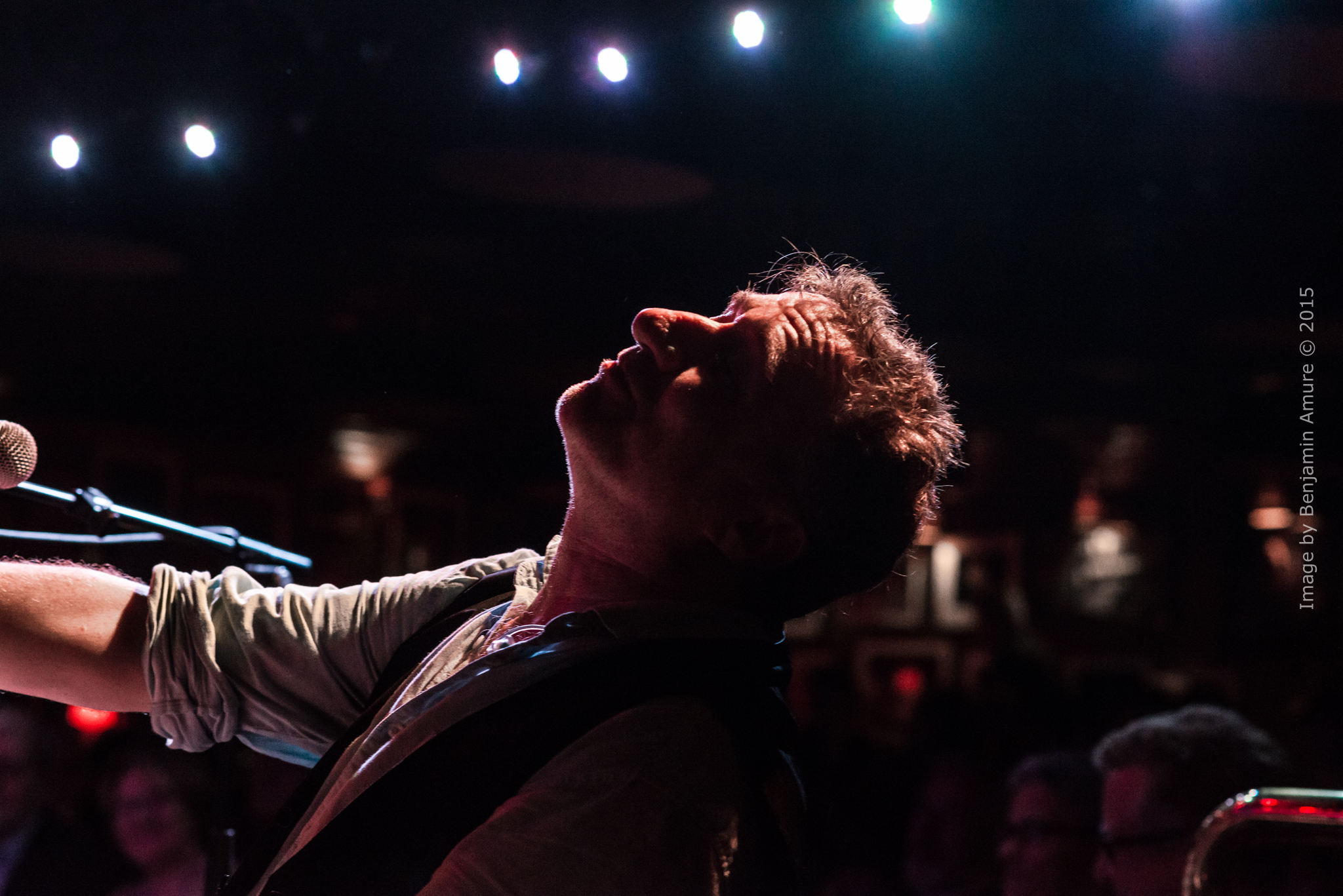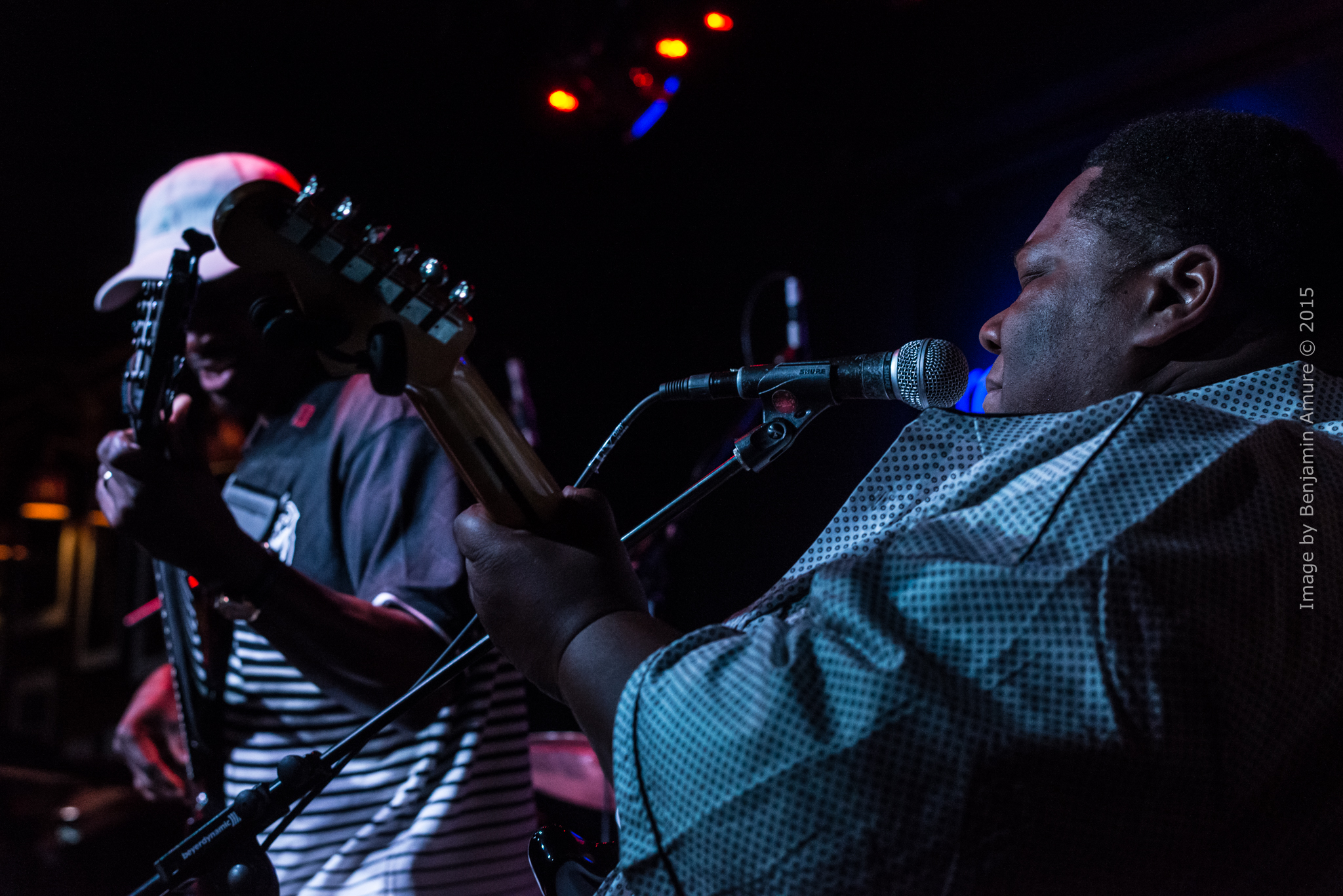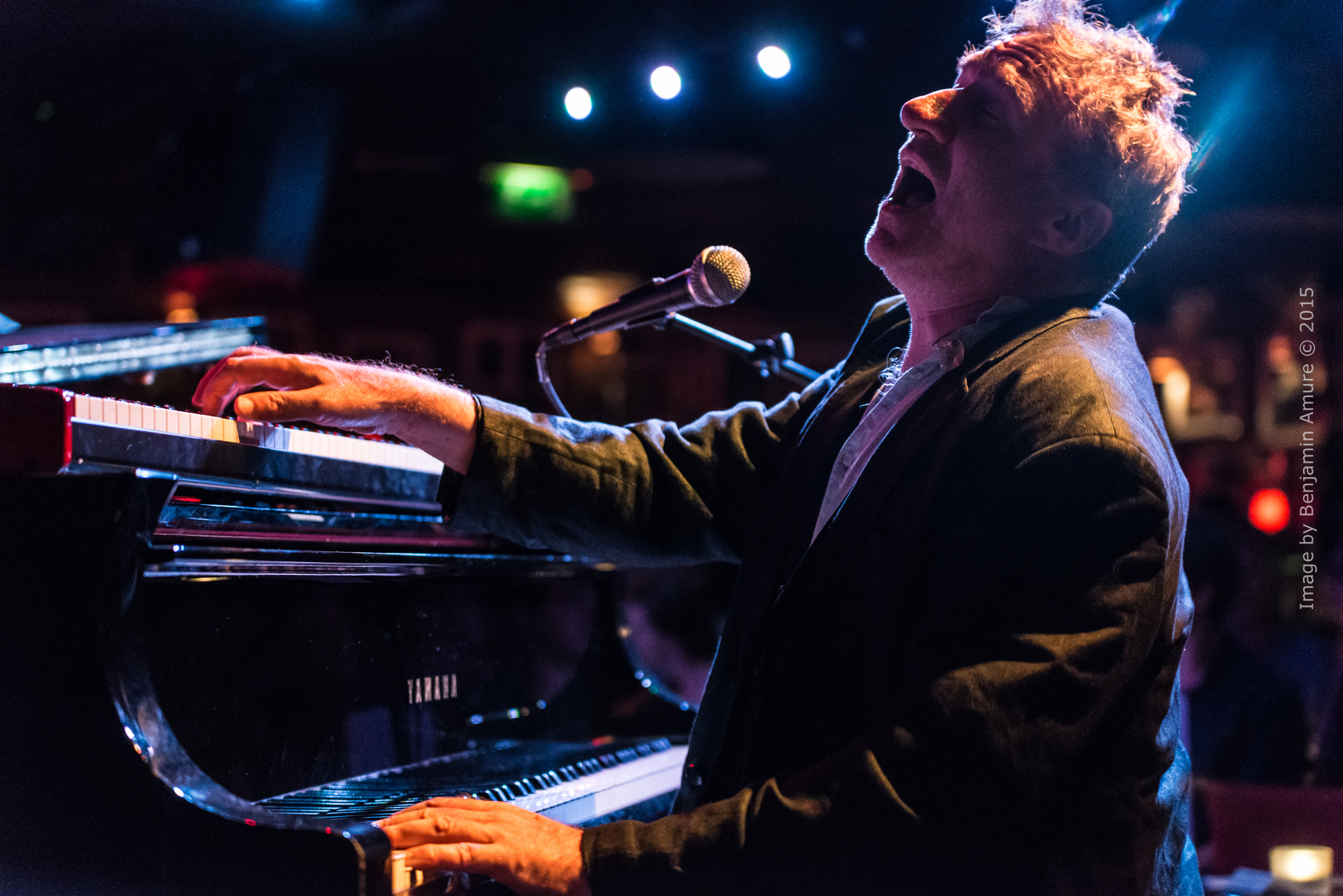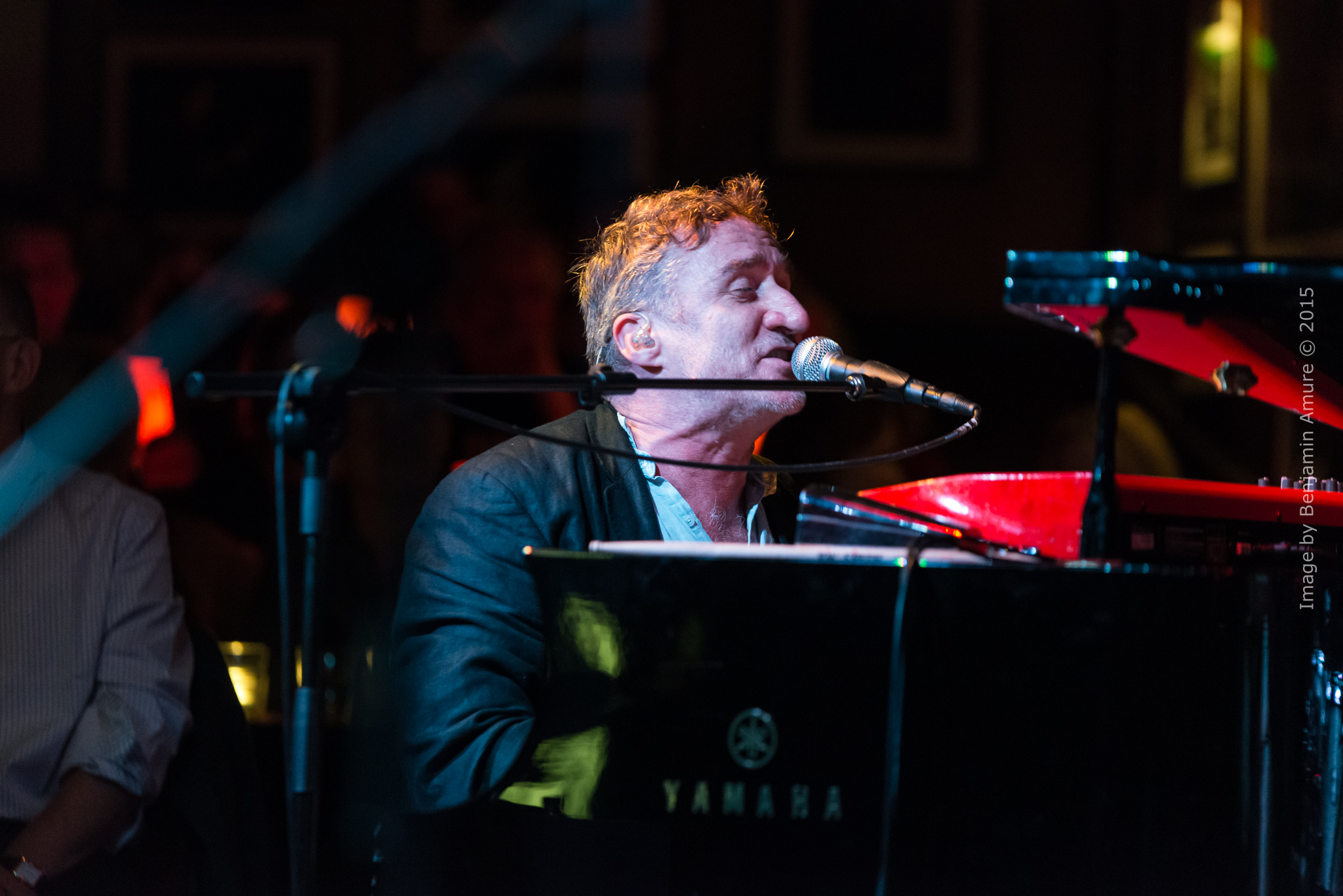His speaking voice – dry, distinctly English, vessel for a voluminous vocabulary – isn’t what you’d expect. Singing live and on record, Jon Cleary’s relatively rough baritone sounds happy just to be there, its 53-year-old owner funking it up on keyboards, invariably backed by a solid but imaginative rhythm section. But he’s a journalist’s delight to interview: polite but forthright; musically adept but able to discuss the music accessibly; a deep repository of music history, in possession of endless facts while being able to think for himself; and undeniably articulate, especially on the subject of his favourite city, in which he pronounces “New Orlinz”.

He’s lived there for decades, but doesn’t look like a typical NOLA musician. He’s from Kent, England for one thing. For another, he is (and sounds) white. Most of the city’s musical heroes – Louis Armstrong, Professor Longhair, Fats Domino et al. – are black, and Dr. John, one of the music’s most prominent exponents, sounds it. And yet no-one could accuse Cleary of inauthenticity: he’s been steeped in the music of the Crescent City since childhood, and at the age of 19 was playing with Dr. John himself.
“I developed a taste for [New Orleans music], because I was in the midst of it so often,” says Cleary. “We’d sit around the kitchen table and play. I thought everybody played guitar when they were growing up.
“But I didn’t want to be on the outside. I wanted to actually go [to New Orleans] and learn from the inside, while I was young, while my musical ability was still forming. So that’s what I did. The point is, people in New Orleans aren’t trying to sound like they’re from New Orleans. They just do what they do … There’s inside-looking-out and there’s outside-looking-in, and I wanted to cross that line and be inside looking out.”
He checks himself: “I mean, I’m English, I’m not American. But I like having a foot on each side of the line. It makes me appreciate New Orleans music more than someone who was born and raised there, but I can approach the playing of it from the inside, because that’s where I learned to play piano as a teenager and in my twenties and thirties.”
The boundary may be clearer than he’d care to admit. Certainly, he is capable of playing fairly pure New Orleans piano music: at Ronnie Scott’s last Saturday, he broke into the crowd-pleasing “Tipitina” after briefly limning its lineage. But on his records, including GoGo Juice (his latest excellent LP), fairly straightforward urban soul-funk is substituted for the idiosyncratic rolling rhythms associated with his hometown. The elements are there: strong drums, vibrant horns, good vibes, familiar lyrical themes. But give GoGo Juice a spin, and if not for the name-checks in the lyrics, you’d be hard-pressed to pin it all to New Orleans.

This is somewhat surprising, given his response when I ask him who he thinks New Orleans’s new musical heroes are. “The guys I like are the old guys, and most of them are dead and gone now; as for the up-and-comers, I don’t honestly know. There are probably some really talented people coming up, but I don’t see many people doing anything new that couldn’t come from anywhere but New Orleans. They’re good technicians and play with a lot of soul, but as far as new bands are concerned… I don’t know.”
Perhaps I’m being a little harsh – listening to GoGo Juice again, some of the drum tracks are identifiably New Orleans-y, and some of the horn arrangements (some by NOLA maestro Allen Toussaint himself) recall the zydeco arrangements of BeauSoleil or Buckwheat Zydeco. And to say that the music isn’t all redolent of New Orleans isn’t to say that Cleary isn’t a truly gifted musician and arranger; as claimed on his website, Bonnie Raitt once called him “the ninth wonder of the world”. He’s busy touring Estonia, Scandinavia and Japan (among other places) to enthusiastic audiences.
But it’s possible that the difficulty of conjuring up that elusive New Orleans sound is what subconsciously eats away at Cleary after the recording process is over and the record’s on the shelves. “If you’re any good at what you do,” he says, “the price you pay for that is never being satisfied. That’s what makes you want to go and do it again. Honestly, once my records are made I hardly ever listen to them again, ‘cos all I hear is things I should have done better.”
He claims that these regrets are technical affairs, though. It’s more to do with the multitude of considerations that can’t all be fulfilled: “how well the songs sit together; the keys you pick; the tempi; the subject matter; the lyrics; the arrangement of the instruments; the sequence and length of verses and choruses; the length of solos. There’s a myriad of possibilities for each song – infinite varieties. And there’s a point where you have to settle on one of them, and say, ‘That’s it, no more.’”

Unlike many of the old NOLA masters, Cleary laboured over edits and overdubs, which he did in his home studio. His songwriting process is generally music led rather than lyric led. I ask him how he comes up with his lyrics. “Sometimes it’s just something I come across,” he replies. “I always write stuff down when I hear good stuff, in a conversation or on telly, or in an article or a novel. Dr John taught me something I’ve repeated a million times since: ‘Amateurs borrow, and professionals steal.’”
I wrongly tell him that Picasso came up with that one – though it’s only fitting that Dr. John appropriated it. (In fact, T S Eliot coined the aphorism “Immature poets imitate; mature poets steal” in 1920.) Cleary moves on.
“You find a line somewhere and shamelessly think, ‘I can use that in a song.’ So the notepad on my iPhone is just full of ideas that might never get used, or stay unused for a week or [a decade]. Like ‘GoGo Juice’. I don’t even know what ‘GoGo juice’ is, I just thought it’d be a great title for a song.”
GoGo juice is American slang for gasoline, the name of a Christian café in California, and an actual juice that contains ingredients too variously listed and ascribed to be definitive. For the purposes of the song Getcha GoGo Juice, though, the words don’t have much semantic meaning: they’re just another set of rhythm tools. It’s one of the highlights of his set at Ronnie Scott’s, along with Tipitina, Help Me Somebody, Groove Me, and his slinky, powerfully drummed version of the Meters’ classic Just Kissed My Baby.

The studio LP contains few weak links other than Step Into My Life, which would be soporific if it weren’t such a pronounced failure, and such an oddity – coming as it does on the heels of the soulful, rhythmic Beg, Steal or Borrow. Bringing Back the Home flirts with lyrical cliché before attempting to snog it drunkenly, and the vocal affectations of Love on One Condition may grate. But the other songs work pretty well.
His live presence works better. Backed only by his superb New Orleans band, the Absolute Monster Gentlemen, the sound has a musculature absent from much of his studio work. The audience is typically British – reserved and far from raucous, but appreciative. As might be expected, Cleary’s favourite audiences are those found in New Orleans; but he expresses a fondness for one audience much farther from home.
“Japan is a great place to play, because they really dig it. The first time I went to Japan was 25 years ago. I played at a festival with Johnny Adams, a New Orleans singer at the time who’s no longer with us. The audiences were very polite and respectful; at the end of the show they politely applauded, before filing out in silence, quickly. [But there’s now a] generation of kids who are noisy; they get it. They jump up and down, all very enthusiastic. They really let you know they’re enjoying it. They hang on every note. I like audiences that are very attentive, but make noise too. If it’s too much like a public library, it’s hard to get all the juice out.
Live and in the studio, Cleary and his band may not always conjure up music that plants listeners squarely in New Orleans; a lot of it, while excellent, is too generally American. But the Big Easy is never far from Cleary’s mind. “New Orleans music always gets people up and [happy],” he repeats. “It’s actually a sad town with quite a sorrowful history, but its music has always been a sort of medicine. The most terrible things happen, but you make a joyful noise and somehow turn it into a party. In New Orleans they bury people with jazz music.”
He doesn’t generally listen to that sort of music when relaxing, as it tends to send his critical faculties into overdrive, in the same way that professional writers find themselves automatically analysing, deconstructing and mentally improving other writers’ sentences even in their spare time. He prefers reggae and Latin music. I compliment Zulu Strut from his 2004 album Pin Your Spin.

“I wrote that one years and years ago,” he explains, “when I lived in London. I loved what Latin music I heard, but … we’re talking about 1984, when there wasn’t really a Latin scene, or an explosion of Cuban music. I really didn’t know anything about it. I felt I had a propensity for that style, but it was my impressionistic take on somewhere between highlife and Latin. I had a little demo on a cassette tape I made at someone’s house, and years later, when we did the [LP], I needed an instrumental tune [with] a different flavour. I played it on guitar [as a demo], we recorded it, called it ‘Zulu Strut’, and that was that.”
We discuss the song briefly. Listening to him talk about music is illuminating, his erudite articulacy joining thoughts like his fingers connect notes. “It was meant to be an impressionistic hybrid of a few different things that were all linked, though there was a New Orleans imprimatur on top of it. I used to go to Cuba quite a lot; I love Cuban son [sic]. So there’s an element of that in the bass patterns. And the [piano voicings] on the right hand are very similar to the New Orleans right-hand voicing. So it’s not a big jump to go from one to another.”
Given that he’s a gifted arranger, bandleader, songwriter and pianist, it was something of a surprise to learn he can’t read sheet music. But neither could Lennon-McCartney.
“I taught myself how to play through reason and logic,” says Cleary. “I think I have a very thorough understanding of how it all works, but I’ve never had any formal musical training. I used to get thrown out of music lessons for being too disruptive. I had two piano lessons until the guy realised I was just memorising whatever he played and playing it back by ear.”

He’s smart enough to realise the value of music theory, though: “Much in the same way as you can speak a language fluently without knowing all the grammatical terms and how to analyse them, that’s how I play music. Not being able to read music well is not something I’m proud of, but I do think that sometimes if you’re taught in an academic context, your brain tends to get hardwired into thinking in certain ways, which can prevent you from having the freedom to express yourself like a musician who just worked it out by themselves. And if you do learn to play by ear, then if you don’t make that quantum leap into understanding the theory, you’re limited [in that way too].”
As musicians go, Cleary’s fairly modest. He does understand the basic rules of musical notation, and sings out his horn arrangements accurately enough for them to be transcribed by an amanuensis – though on his latest album, he has had, as previously mentioned, assistance from the great Toussaint himself.
***
The more Cleary talks about New Orleans itself – a city that has done so much to excite my imagination and arouse my wanderlust over the last few years – the more I am enthralled. The main reason for this is the lack of scales covering his eyes. It’s clear he loves his hometown deeply, and yet he is aware of its shortcomings; he describes the shifts and mutations without overly romanticising a city already known for its romanticism. It’s worth quoting him at length on the subject of the Crescent City.
I ask him how big it is. “In Greater New Orleans, the population is probably about a million,” comes the response. (The population of New Orleans itself is about 380,000.) “It’s pretty small for a city. And it’s remote, too; its history has more to do with the colonial world that lies to the south – Cuba and Haiti, mainly. It only became part of America when it was sold by Napoleon to the United States in the Louisiana Purchase [in 1803]. If you want to be a lawyer in Louisiana, you have to go to study Napoleonic law for an extra couple of years. The law is different there.
“The culture’s different too… in the New Orleans countryside, they still speak French. Cajun and Creole French. In the city they used to speak French, but that was at the turn of the [previous] century; that’s long gone. There a still a few funny expressions left over that got badly translated into English. There’s a French expression, ‘faire le marché’ – to do the shopping. When it got translated into English, it became ‘make the shopping’. So people say, ‘I’m going to go make groceries!’ And the sidewalk – old people call it the ‘banquette’ [pronounced ‘banket’]. The pronunciations have become Americanised and garbled, but you get little traces of the French. And architecturally, New Orleans is quite distinct from anywhere else.”
Quite Gothic? I suggested, with Interview With The Vampire in my mind’s eye. Cleary’s answer is typically straightforward: “I don’t know what Gothic architecture really is. There’s colonial architecture in the French quarter; it’s Spanish-style, and has more in common with parts of the Caribbean. Banana trees, alligators, swamps.”
Is it changing much? “It’s always been behind the times. It’s a long way from anywhere else: it’s eight hours’ drive to Houston, eight hours to Atlanta, 12 hours to Miami. And until the 1960s when they built the interstate [highways], it was physically very cut off. It had small roads, and New Orleans is surrounded by miles of swamp and jungle. Consequently, it’s always been a little bit out of date, which is one of its charms – you always go there and feel like you’re living two weeks ago, or two years ago, or 20 years ago.”
Indeed, New Orleans is often known as the City That Care Forgot; but this moniker is becoming less and less appropriate. “[Hurricane] Katrina dragged New Orleans kicking and screaming into the 21st Century, really. There are a lot of people moving to New Orleans. It has one of the highest numbers of Internet start-up companies, and in many ways it’s a success story. It’s booming.

“But that has meant that a lot of people who liked it the way it was are feeling that the old New Orleans that they loved – the backwards, sleepy, forgotten Deep South aspect of New Orleans – is getting rubbed away pretty quickly. And the joy of New Orleans is that it’s not like Houston, it’s not like Atlanta, or San Francisco or New York or Miami. It’s got this entirely different feel. People used to say it was the closest you could get to leaving the United States while still being in it. And I’m one of [those people]. I don’t want it to change.”
Do you feel it’s palpably changing? I ask. “Yeah. But places change anyway, whether you like it or not, so it’s hard to know the extent to which Katrina made it change at a different rate. The question that’s being asked in New Orleans is the same that’s being asked everywhere else – the gentrification thing. In New Orleans, the heart of the city is being gentrified, and arguably that’s a really good thing in many ways. The downside is that the ‘New Orleans’ culture – a real working-class thing – [might disappear]. It’s terrible if the baby gets thrown out with the bathwater. The good thing is that old houses get fixed, which might otherwise have fallen down.”
Do they get fixed and made to look like a gentrified house, or do they still retain their quaint rickety feel? “When old houses get fixed, they just get a fresh coat of paint and prevented from falling down. [They look] like they would have looked when they were first built, which is good. But I kind of like it when they’re a bit shabby, and look like they’re about to fall down. That’s what I love.”
Would you want to live in one, though? “I do live in one! I’ve always lived on one that’s on the verge of collapse. I wouldn’t have it any other way. I live in an old hardware store, and I used to live in an old grocery store. Occasionally you’d hear a big bang and think, ‘Oh god, a bit of the house has just dropped off.’ But to me it was like a metaphor for the whole city. It was in a wonderful state of arrested decay – except it wasn’t arrested, it was gradually falling down.”
The influx of money, of course, means that prices are going up, with house prices up 43 per cent since 2009. In the first half of 2015, the average price of a house was $334,280. “People are getting priced out,” says Cleary. It’s always been a poor city, but despite the poverty and the high crime rate – or perhaps because of it – people would counter it by starting parties and street parades. Mardi Gras, jazz festivals – celebrations of the good things in life, even to the point of burying musicians with a party, with people dancing on graves and blowing trumpets.”
That’s the way I want to go, I say half-jokingly; but Cleary continues, impassioned.
“So the poor people are getting moved out of the ghettos. There are housing projects in New Orleans – quite ugly compared to the rest of the city, [which] is full of old houses with curlicue details. The brick housing complexes were built initially to house poor people, and were considered a real step forward in social progress. They gradually became ghettos with concentrated generational poverty and crime. There were several of them dotted all over the city, and you couldn’t get near them. Policemen wouldn’t go into some of them, they were so bad.
“When [Katrina] happened and everyone was evacuated, the local authorities went and padlocked the whole lot of them, and wouldn’t let people back in. They thought it a marvellous opportunity to get rid of these bloody things once and for all, because as long as they were there, New Orleans would always be plagued with dreadful problems. And so they knocked them down, and replaced them with mixed-income houses. But a lot of people that lived in those projects can’t afford to rent [these new lodgings], and certainly can’t afford to buy.”
Indeed, in the last year, over a hundred New Orleans properties worth over $1m have been purchased – a 33 per cent rise since 2013. In districts such as Bywater and Marigny, which were less affected by Katrina, fully renovated and kitted-out homes range from around half a million to a million dollars. But even these figures don’t approach the cost of the houses in the French Quarter and the Garden District, where so much of the music – New Orleans’s biggest legacy – has been concentrated for decades.

The price creep – as well as the necessarily slow process of recovery and renewal – is likely what has been keeping the city’s population below pre-Katrina levels; around 100,000 people who left after the storm have not returned. “But those are the people who are out there on the streets on Mardi Gras day, bashing out the rhythms and singing all the old songs,” says Cleary. “That’s the repository of the culture. You lose those people at your peril.”
Acknowledging that the Big Easy is no longer quite so easy demographically, architecturally and financially, I ask if the musical culture has changed a great deal, and whether Cleary sees it changing for the worse.
“The things I was just describing [mirror] the plight of the music. A lot of musicians are moving to New Orleans because it’s the one place where you have a tradition of ‘ethnic music’, for want of a better term. Music that’s been handed down from generation to generation in certain contexts that have allowed that to happen, like carnivals.” Ironically, the very musicians keeping the tradition alive are rapidly losing gigs to young incoming musicians who are willing to perform for a fraction of the price.
Are the incomers playing New Orleans music? I ask. “A lot of the musicians coming in from out of town are really good. [But] they play music that’s New Orleans-y, New Orleans-ish. A lot of people come and play old-time jazz that’s popular with tourists. But I’ve spent three-quarters of a lifetime digging out the real stuff, and there’s a distinction between the real stuff and the pastiche versions that are trotted out for visitors who can’t tell the difference. And I think it’s important that people know, because the real New Orleans stuff is so good.”
Is the distinction describable? “No, not really. You can’t really describe music in words; that’s what makes it so great. You can talk about the boxes that music comes in, but you can’t talk about music itself, until you start talking about flatted fifths and raised ninth chords and 1-6-2-5 [progressions], and things that mean nothing to anyone who isn’t a jazz musician.”
Still, he admits that old music can’t become a museum piece; it needs to adapt. “Younger musicians hear the old stuff, and usually they’ll reject it and do something new, but they’ll find – because they’ve grown up surrounded by the old stuff – that a lot of it’s sunken in by osmosis, and comes out in what they play. They’re not trying to make it sound like that, but that’s how it naturally comes out. [What you hear as a kid] gets hardwired, and it comes out when you’re improvising. It might be your grandpa playing, or your uncle, or your next-door neighbour’s uncle, but it gets hardwired [all the same]. That’s how the tradition evolves, how the baton is passed down through the generations.”
For all his belief in traditions, Cleary is not a religious man; but he cannot fail to be touched by new Orleans’s rich gospel tradition. Regular churchgoers, dipping into the song canon on a weekly basis, are plentiful there. Cleary equates New Orleans musicianship with the work of preachers and gospel conductors: “We’re kind of alchemists – our job is to make that magic happen wherever possible… because that’s what people do in New Orleans. Music is the social glue there; it accompanies everything. You don’t have to be a musician in New Orleans to be around music all the time. It’s the soundtrack to your everyday life.
“In other parts of the world now, it’s a commodity produced and digested via another organisation that dispenses or distributes music. Now we’re so bombarded with Muzak, in supermarkets, in taxis, wherever you go – it’s noise pollution. Sometimes it’s quite pleasant noise pollution, but you can’t turn it off.
“But there was a time in our great-grandparents’ generation where if you wanted to hear music, you had to be sitting in the same room as a musician! There weren’t other diversions; people were more inclined to play music because there wasn’t much else to occupy your time. In a lot of the modern world, music’s died out. But if you go to places that don’t have those distractions, it’s still very musical. Cuba, for instance.”
The purpose of music has changed, too. “In New Orleans, if the music is played right, it can lift you up. I think in other parts of the world, people have forgotten that. You go and get pissed and jump up and down. But the job of a musician in New Orleans – it’s to make you feel better. It’s like going to see the doctor.”
So that’s why he calls himself Dr. John? I ask. “Yeah,” laughs Cleary. “It’s a great job to have. You walk into a room with a bunch of musicians and get to work, and gradually it builds up and everyone gets into it, and you have a whole room of people all concentrating on what you’re playing. Everybody’s on the same page. And then something happens, and you get goosebumps, and you can feel the whole room lifting up. I’m not a religious person, but that is like a religious experience. It’s like what they do in church every Sunday – whip it up into a frenzy with music.”
***
The interview ends with me asking about how he began playing piano, but unsurprisingly – font of history that he is – Cleary develops his answer into a musing on the birth of New Orleans as we know it.
I remember reading, during my preparation, that he first wanted to play piano (rather than the guitar he had learned as a child) upon hearing an ivory intro to an old song that caught his ear. The intro was by Dr. John. I asked him what the song was called; turns out it was Farewell to Storyville, as sung by Danny O’Keefe – a 1973 cover of an old song from the 1947 film New Orleans, featuring Billie Holiday and Louis Armstrong.
“There was an area called Storyville in New Orleans,” recounts Cleary, almost as if he’d been there, “which like any other port city had a lot of prostitution, a lot of musicians, a lot of dope, a lot of crooks. Whatever the [seafarers] needed, there was someone there to supply it.
“And New Orleans had always been a Catholic, creole city. When the Americans moved in, a lot of them were quite puritanical, and were quite shocked at what the creoles considered acceptable – quite a laissez-faire approach to morals. The Americans became the dominant force, and said, for religious reasons, ‘We wanna get rid of all this.’ And they tried to get rid of it, and they failed, because it was already dyed in the wool.
“So one city politician said, ‘If we can’t get rid of it, we can restrict it – to one small area, so that the good citizens of New Orleans don’t have to look at this disgusting behaviour.’ And so they confined it to one area – and it flourished, because now [people] knew exactly where to go. And it took off, and was a roaring success, to the chagrin of the guy whose idea it was. His name was Sidney Story, and they named it Storyville after him. So his name will always be synonymous with all the things he tried and failed to get rid of.”
Storyville flourished in the late 19th century until 1917, around the time America entered the First World War. “Ships were moored at the port of New Orleans, ready to enter the fray, and the sailors were all in Storyville getting fucked up, getting syphilis, getting into fights, getting thrown into jail. The US government [well, actually the Army and the Navy] said to the city councillor of New Orleans, ‘Lock it up. Get rid of it, or we’ll withdraw federal funds.’”
So they duly went in one morning and locked up all the joints. “The party was over,” says Cleary quietly. “And so the song is called Farewell to Storyville.”
At this point, I decide to bid farewell to Clearyville. Thanking him for an illuminating evening, I wander out of his sister’s home in Highbury, his latest album playing in my ears. I nod along, with a slightly richer understanding of the music, or at least its context. But as great as he is a raconteur, he’s an even better musician. Catch him when he’s next in London. He may not be New Orleans incarnate, but you’ll have a hell of an evening – particularly if his Absolute Monster Gentlemen are in town.
Images courtesy of Danielle Moir and Benjamin Amure





































